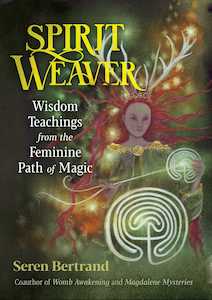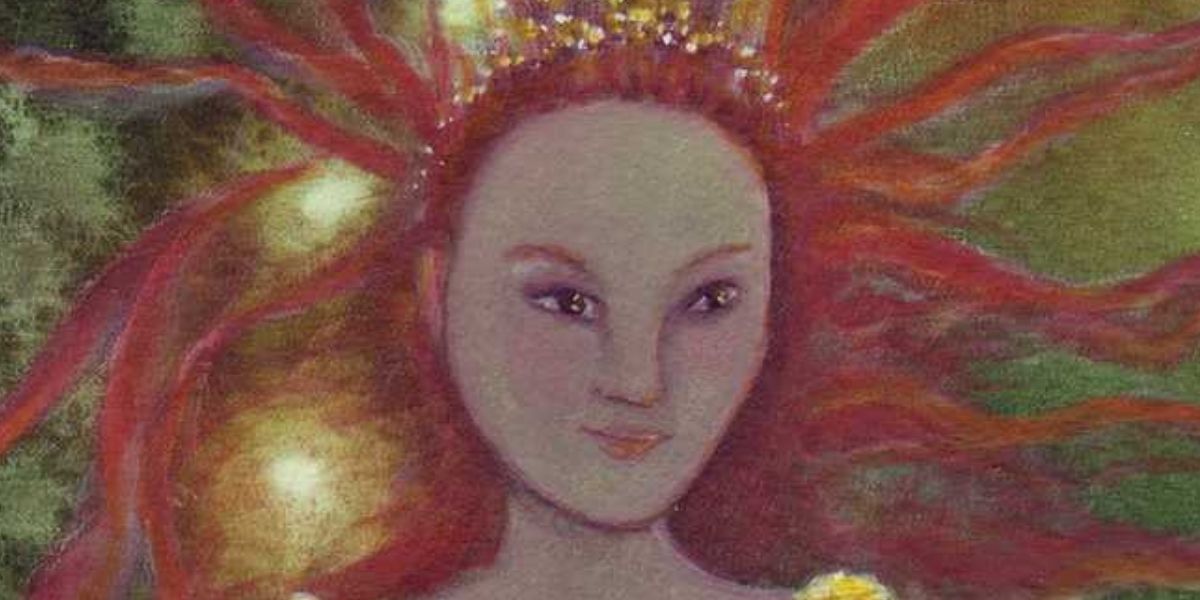
Spirit Weaver: Wisdom Teachings from the Feminine Path of Magic, by Seren Bertrand
Bear & Company, 1591434351, 256 pages, May 2022
Spirit Weaver: Wisdom Teachings from the Feminine Path of Magic by Seren Bertrand was balm for my aching soul. Recently, I have been rather withdrawn, tending to my inner world over making strides towards accomplishments in the external world. I’ve been quite content exploring and feeling into the changes taking place within myself as I enter a new phase of my life
But amid the soul-shifting happening, I was being quite hard on myself, lamenting about “not being productive” and chastising my need to remain in my domestic sphere, which has felt quite like my safe haven or nest during this time. It wasn’t until I spent two days in bed, switching off between deep-diving into the wisdom of this book, journaling, and napping, that I felt a very rooted, authentic connection to my own feminine magic was restored.
“We have to nest. Not to always be somewhere else.
Wild creatures know how to nest. They know how to leave–and how to return.
There is great spiritual power in pottering–in the garden, in the kitchen, just being around the house, the home. Tending the herbs in the garden, making a fresh-brewed tea, the sensual art of cooking. Or entering the prayer chamber of the sofa, lounging with God, in intimate conversations and occasional snoring.
Nowhere to go, nothing to do. No grand theories to unite. Just to relax and be.
Home brings us back down to Earth. It makes us real. It grants us “enrealment.”
It is imbued with Womb magic; the power of Earth, of life, of love, of the real.”1
Bertrand is a skilled spirit weaver and visionary creatrix, who has done so much research on the lost global feminine wisdom traditions. She has also co-authored Womb Awakenings and Magdalene Mysteries with her husband Azra. Both of these books were life-changing for me, and I highly recommend them as well for anyone interested in feminine magic.
What sets Spirit Weaver apart from these other two books though is that this one feels more personal and the wisdom shared can be easily incorporated into one’s life. Whereas Womb Awakening and Magdalene Mysteries are both 560 pages of historical, anthropological, and spiritual revelation, Spirit Weaver is about half the length and is based on Bertrand’s personal insight and heartfelt experience of living the path of feminine magic.
Her first-hand perspective really hit home for me, as it felt like an invitation to walk alongside her as she shares what she’s learned throughout her journey, much like listening to a friend. Her soothing way with words was a more creative approach to sharing the mysteries of this path, intuitively opening new chambers within my own psyche and soul to explore. And it’s definitely worth noting though she explores feminine magic worldwide, Bertrand’s personal narrative of her ancestry to her homeland of England is a prominent theme.
“Sitting at the heart of these essays I share with you is the story of my personal ancestral lineage at Mam Tor (Mother Mountain), in the Peak District of the Old North of England, once the grail lands of Maid Marian and Robin Hood and the ancient tribe of the Brigantes–who worshiped the goddess Brigantia, the ancien mother of the old north–who were once led by powerful queens. These lands are an ancestral soulmate within me, the earth placenta of my childhood.”2
The book is composed of 50 essays divided into five sections: “Spinning Our Web”, “Growing Our Roots”, “Weaving Our Healing”, “Dreaming Our Magic”, and “Enchanting Our World”. While the sections have essays relevant to the overall theme, each one stands alone as a unique, insightful reflective piece of writing. I choose to make my way through chronologically, but one could absolutely pick and choose the essays or sections that feel relevant to them in each moment.
One thing I loved about this book was the brilliant paintings throughout the book that was rich with symbolism, featuring images of women, animals, spirals, and more. It felt as though each picture was perfectly placed, inspiring revelation as I turned the page after reading a specific essay to see a creative expression of the essence, energy, and themes Bertrand is describing. Sometimes, I would end up staring at the imagery for a good five to ten minutes, sometimes contemplating its message and other times just admiring the beauty. Plus, there is variation in font color too, which adds to the beauty of the book; it’s not just black and white, but alive with color for visual appeal.
In addition to paintings, there’s also some photographs included too, such as wells, festivals, and even an ancestral photograph of Bertrand’s family. These pictures definitely made Bertrand’s writing more realistic because I could see exactly what she was describing, even if I haven’t visited these places myself or experienced the culture of the lands she describes, especially her homelands of northern England. Now I just want to go take a pilgrimage!
Another thing I really enjoyed about Spirit Weaver is how Bertrand offers ideas for self-reflection or advice about how to integrate what she’s just written about in her essay. For instance, following the essay “Feminine Archetypes: The Witch and the Priestess”, Bertrand invites the reader to reflect on which one is more resonant to them right now. Following another essay, “Rooted Power: Feminine Spiritual Path”, Bertrand shares a way to find the balance between one’s rooted power (embodiment check-ins) and their infinite love (affirmation). While not every essay has something like this at the end, these prompts definitely helped to integrate Bertrand’s writing.
Overall though, I think my absolute favorite thing about the book was the content. Bertrand delves into many aspects of the feminine with such insight. As someone who also walks the path of feminine spirituality, it felt like a homecoming to read Bertrand’s thoughts and reflections. I’m constantly vacillating between whether to call my path one of witchcraft or priestesshood, while also contemplating how to embody this practice in my daily life. Mary Magdalene and the Christ path has always had a special place in my heart, which is definitely not discussed much in witchcraft, so I loved soaking up Bertrand’s wisdom about that.
But the topics covered a wide range of feminine spirituality, such as Moon magic, Celtic traditions, Dankini magic, working with the shadow, romantic love as a spiritual pathway, the wisdom of Grandmothers, mermaids, and so much more. This might sound like a smorgasbord, but it wasn’t at all like that; it’s a rich tapestry of all aspects of the feminine skillfully woven together.
What I was most surprised at was her essay called “Lady Saturn: Lineage of the Cosmic Witch”. I recently did a whole astrology presentation about the feminine aspect of Saturn as Crone, and I was thrilled to read another’s perspective about the VERY overlooked female attributes of Saturn. Bertrand writes, “Lady Saturn is the darkness of wisdom, of Sophia. She is the grand cosmic witch.”3 This just set my passion ablaze and spurred me on in my own research!
I was also just overcome by what I read in the section “Epiphany: Three Wise Witchy Midwives” where Bertrand discusses the Christmas Witch La Befana. As an Italian-American, the past three yuletide seasons, I’ve been deepening my relationship with la Strega Noel, and Bertrand provided more information in this section than I had been able to find thus far. I loved learning about how “The sacred Christmastime of Epiphany was once the heartland of the feminine mysteries, celebrated by many feminine folk traditions.”4 Suddenly, it made a lot more sense why this has become such a special time of the year for me, as I walk this path.
All in all, Spirit Weaver is a treasure trove of wisdom about the magic of the feminine mysteries. I highly recommend this book to all who feel called to walk the path of the feminine spirituality, in whatever form this looks like for them. Bertrand covers such a wide-range of topics that each reader is sure to take away something meaningful for their own personal journey. Bertrand truly continues to do such a service to the feminine spiritual pathway, educating readers with her research and courageously sharing her own experience to illuminate the way for others. This is a book that I know I will be returning to time and time again, as I continue to weave my own way immersed within the all-encompassing divinity of the feminine.
Alanna Kali is an astrologer, numerologist, and pioneer spirit that loves to explore life through the lens of depth psychology. She has a passion for studying the humanities and social trends. Her academic work is centered upon reuniting body, mind, and spirit through eco-psychology. She loves reading, spending time in nature, and travel.


